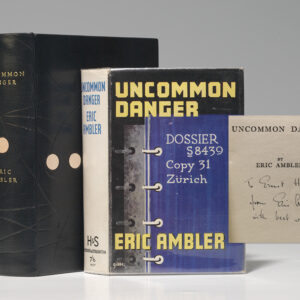Description
“AMERICA’S FIRST GREAT SCIENTIFIC CONTRIBUTION”: A GREAT RARITY, EXCEPTIONAL PRESENTATION/ASSOCIATION FIRST COMPLETE EDITION OF FRANKLIN’S ILLUSTRATED EXPERIMENTS AND OBSERVATIONS ON ELECTRICITY, 1769, PRESENTED BY FRANKLIN TO HIS CLOSE FRIEND THOMAS COOMBE, WITH FRANKLIN’S INKED ANNOTATION ON THE FIRST PREFACE LEAF
FRANKLIN, Benjamin. Experiments and Observations on Electricity, Made at Philadelphia in America? To which are added, Letters and Papers on Philosophical Subjects. The Whole corrected, methodized, improved, and now first collected into one Volume, and Illustrated with Copper Plates. London: For David Henry; and sold by Francis Newbery, 1769. Quarto, contemporary three-quarter brown sheep rebacked with original spine laid down, original black morocco spine label, marbled boards. Housed in a custom clamshell box.
First complete edition of “the most important scientific book of 18th-century America” and “America’s first great scientific contribution” (PMM 199), an exceedingly rare presentation/association copy with Franklin’s inked annotation to the first leaf of the Preface, identifying it as “by Dr. Fothergill of London,” this copy sent from London in January 1769 to Franklin’s close friend and colleague in Philadelphia, Thomas Coombe, whose son Thomas Coombe, Jr. was then staying with Franklin in London and whose own inscription appears on the half title verso. With seven copper engraved plates (two folding), and material and footnotes appearing here for the first time, in contemporary sheep.“Franklin’s most important scientific publication,” Experiments and Observations contains detailed accounts of the founding father’s crucial kite and key experiment, his work with Leiden jars, lightning rods and charged clouds (Norman 830). “The most dramatic result of Franklin’s researches was the proof that lightning is really an electrical phenomenon. Others had made such a suggestion before him—even Newton himself—but it was he who provided the experimental proof” (PMM). “The lightning experiments caused Franklin’s name to become known throughout Europe to the public at large and not merely to men of science. Joseph Priestley, in his History of Electricity, characterized the experimental discovery that the lightning discharge is an electrical phenomenon as the greatest, perhaps, since the time of Isaac Newton? Franklin’s achievement? marked the coming of age of electrical science and the full acceptance of the new field of specialization” (DSB). Franklin’s Experiments is “America’s first great scientific contribution” (Howes F320). This first complete edition is the fourth edition of the original work; the earlier editions appearing from 1751-54 were carelessly published with each issued in three parts as separately published pamphlets usually bound together. Franklin edited this new one-volume edition himself, significantly revising the text, adding for the first time a number of his own philosophical letters and papers, introducing footnotes, correcting errors, and adding an index (Cohen, Benjamin Franklin’s Experiments). With engraved ornamental initials, head- and tailpieces. With errata and advertisement leaf (rarely found) bound after title page; with half title. Occasional mispagination as issued without loss of text. Grolier American 10. Sabin 25506. Ford 307. Papers of Benjamin Franklin Vol. 15:286, 290-93; Vol. 16: 112-13. See Horblit 31a. Franklin’s elegant inked annotation appears on the first leaf of the Preface, identifying it as: “By Dr. Fothergill of London.” Franklin sent this copy to Thomas Coombe of Philadelphia, a colleague and close “friend of long standing? he shared Franklin’s scientific interest” (112n). His son, Thomas Coombe, Jr., was in London in late 1768 and early 1769 to be ordained into the Church of England and boarded with Franklin while there. This exceedingly rare presentation/association copy further contains an inscription on the verso of the half title, written in the hand of Thomas Coombe, Jr., that reads: “From Dr. Benjamin Franklin to Mr. Coombe of Philadelphia. London Jan. 14th 1769.” We know from correspondence in the Franklin Papers that Franklin sent this copy of his Experiments and Observations, along with several others, from London to Philadelphia in late January 1769. Thomas Coombe, Sr. then wrote Franklin a letter on April 17, 1769, thanking him for the book. With two bookplates (one the armorial bookplate of a Coombe family descendant). Occasional contemporary marginalia (not in Franklin’s hand). Faint inkstamp to rear pastedown; tiny numerical label to front pastedown above bookplates.Inscriptions fresh and crisp, interior with light scattered foxing, faint dampstaining to front free endpaper, some rubbing, edge-wear to original boards, small bit of wear to joints. An exceptional presentation copy with a most memorable association.



